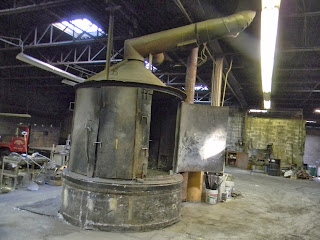I. Broomfield and Son, Inc is about the last lead foundry in the eastern US -- maybe in the whole US, specializing in pouring production and custom sail boat keel ballasts. They did a great job on the ballast for a 34 foot centerboard catboat that was built at the Workshop on the Water at the Independence Seaport Museum in Philadelphia (ISM,) a few years ago, and thus came highly recommended. They most definitely did not disappoint.
My wife and I got to meet all the people at Broomfield, including Michele, with whom I have had multiple phone conversations and exchanged many e-mails in the process of getting to this point. Also, Tom, who actually cast my ballast, and Shannon, who did a beautiful job of grinding it. David Broomfield, the third generation of his family to operate the foundry, was extremely gracious and gave us a tour of the place. Broomfield and Son is a wonderful old family manufacturing business, of the kind that used to be common in the US, but today, unfortunately, are all too rare.
We began by loading up the ballast in our rented truck, with the help of Tom and his forklift. In the photos below, you can see the eyebolts embedded into the casting to facilitate lifting. They will be taken out with a bar later on.
 |
| Here's the ballast ready to be lifted into the truck. A beautiful piece of work by real craftsmen. |
 |
| Tom moves the forklift into position |
 |
| Dave Broomfield looks on |
 |
| Thank you Dave! It looks great. Shame it has to go underwater. |
 |
| I would prefer if this particular load didn't shift. |
 |
| Here's Tom who took my pattern and made the casting. |
 |
| The heart of the operation is the melting furnace. |
 |
| A mold for a production keel. |
 |
| One of the many production keels awaiting delivery. |
 |
| Piles of scrap lead awaiting smelting. |
 |
| There are a few automotive balancing weights in the inventory. |
 |
| Jeff aims for the back of the truck. |
 |
| Jeff moves the skid into the shop. I keep my feet out of the way. |
 |
| We lifted the ballast by the eyebolts to shift it onto another skid |
 |
| Bob -- a grade AAA belt and suspenders guy -- fastens brackets for stability. |
No comments:
Post a Comment